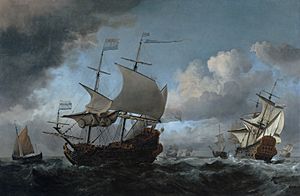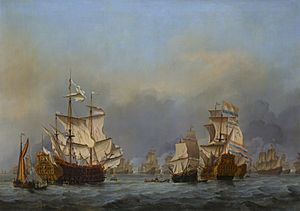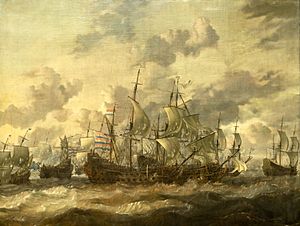Four Days' Battle facts for kids
Quick facts for kids Four Days' Battle |
|||||||
|---|---|---|---|---|---|---|---|
| Part of the Second Anglo-Dutch War | |||||||
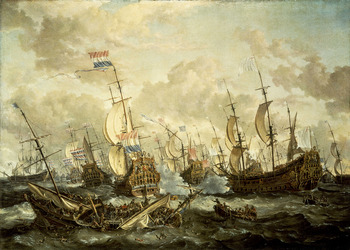 The Four Days Battle by Abraham Storck |
|||||||
|
|||||||
| Belligerents | |||||||
| Commanders and leaders | |||||||
|
|
||||||
| Strength | |||||||
| 79 ships 21,000 men |
84 ships 22,000 men |
||||||
| Casualties and losses | |||||||
|
|
||||||
The Four Days' Battle was a huge naval battle fought during the Second Anglo-Dutch War. It took place from June 11 to June 14, 1666, in the southern North Sea. This battle started near the coast of Flanders (modern-day Belgium) and ended close to the English coast. It is known as one of the longest sea battles in history.
The Dutch navy caused a lot of damage to the English fleet. England lost ten ships and about 1,000 men were killed. Two important English admirals, Sir Christopher Myngs and Sir William Berkeley, died. Nearly 2,000 English sailors were captured, including another admiral, George Ayscue. The Dutch lost four ships to fire and about 1,550 men. Several Dutch admirals, like Cornelis Evertsen and Abraham van der Hulst, were also killed. Even though the Dutch clearly won this battle, the English fleet was not completely destroyed. They quickly repaired their ships and were able to fight again soon after.
Why the Battle Happened
In the 1600s, warships changed a lot. New sailing ships, called "ships of the line," had many powerful cannons. This changed how sea battles were fought. Before, battles were often messy, with ships attacking each other individually. Sailors would even try to capture enemy ships by boarding them.
Over time, navies learned to fight in a "line ahead" formation. This meant ships sailed in a single line, one after another. This allowed them to fire all their side cannons at the enemy. The English fleet often used this tactic well. The Dutch, led by Michiel de Ruyter, sometimes preferred to break through the enemy's line and capture ships.
Both sides also used "fireships." These were old ships filled with flammable materials. They would be set on fire and steered into enemy ships to burn them. Fireships were very dangerous to ships that were stuck or in crowded harbors. However, they were less effective against ships moving freely in the open sea.
The War in 1665
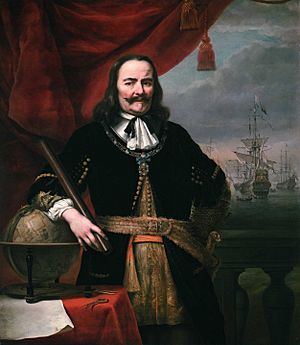
The Second Anglo-Dutch War started in 1665 because England and the Netherlands were competing for trade and power. They argued over control in places like North America, West Africa, and Asia. Both countries refused to back down.
Louis XIV of France had a treaty with the Dutch. He wanted to conquer parts of the Spanish Netherlands. He hoped this treaty would stop other countries from getting involved. England's King Charles II wanted to stop France from helping the Dutch. He also hoped France would not join the war. The Dutch declared war on England in March 1665.
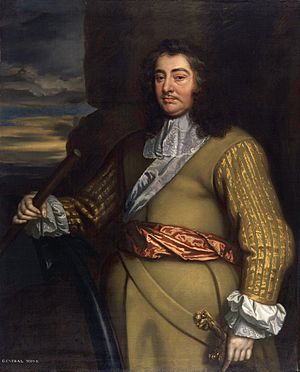
The Dutch leader, Johan de Witt, worked hard to build many new warships. These ships were larger and had more cannons. The Dutch fleet had been confident before the Battle of Lowestoft in June 1665. However, they suffered a terrible defeat, losing many ships and men. De Witt quickly realized that good leaders were more important than just having many ships. He punished captains who showed cowardice. He then chose Michiel de Ruyter to lead the Dutch fleet. De Ruyter was a very experienced and respected admiral.

After their victory at Lowestoft, the English did not fully use their advantage. The Dutch fleet managed to escape. Also, a rich Dutch trade fleet returned home safely after a battle in August 1665. This made the English anxious. They wanted to completely destroy the Dutch navy in 1666. They also wanted to stop Dutch raiders who were hurting English trade.
The English fleet was usually commanded by James, Duke of York, who was the king's brother. But after many English officers were killed or wounded at Lowestoft, King Charles II told his brother not to command at sea anymore. So, the English fleet was put under the joint command of Prince Rupert and the Duke of Albemarle.
French Involvement
France tried to help make peace before the war started. But England refused. After the Battle of Lowestoft, France worried that a strong English navy would interfere with its plans. So, Louis XIV of France declared war on England in January 1666.
Louis planned to bring most of his French fleet from the Mediterranean Sea to join the Dutch fleet in the English Channel. Together, they would outnumber the English fleet. However, the Dutch fleet was not ready as early as France expected. This caused delays for the French fleet. The French and Dutch fleets never managed to meet up as planned during the Four Days' Battle.
Splitting the Fleet
The English knew about France's plan to join the Dutch. So, Prince Rupert was sent with 20 fast and well-armed ships to block the Strait of Dover. His job was to stop the French fleet from entering the Channel. Albemarle, the other English commander, agreed to this, but he expected to have at least 70 ships left to fight the Dutch.
However, many English ships were not ready. Some needed repairs, others lacked enough sailors or supplies. This was because the war was lasting longer than England expected, and it was very expensive. Albemarle became worried. He had only about 54-56 ships, far fewer than the 70 he wanted. He asked the king's advisors if he should still fight the much larger Dutch fleet.
The king's brother, the Duke of York, told Albemarle he could decide. The English thought the Dutch fleet would sail north to meet the French. But this information was wrong. So, at the start of the battle, Albemarle's 56 ships were greatly outnumbered by Michiel de Ruyter's 85 warships.
On the day before the battle, the Dutch fleet was very strong. It had 72 large warships, 13 smaller ones, 9 fireships, and other support vessels. In total, they had 4,200 guns and 22,000 crewmen. It was the biggest and most powerful Dutch fleet ever seen.
The Battle Begins
First Day, Morning Attack
On the morning of June 1, the English fleet saw some Dutch ships. Albemarle soon realized he was facing at least 80 Dutch warships. He decided they had to fight, even though the weather was bad with strong winds and rough seas. He also sent a message to Prince Rupert, telling him to return if possible.
The Dutch fleet was anchored and not ready for battle. Albemarle decided to attack the Dutch rear squadron, led by Cornelis Tromp. He hoped to cripple them before the rest of the Dutch fleet could help. The English fleet attacked around 12:30 PM. De Ruyter was completely surprised. Tromp quickly ordered his ships to cut their anchor ropes and sail away.
Only about 30-40 Dutch ships could form a battle line at first. The English had the "weather gauge," meaning they were upwind. This gave them an advantage. But many English ships did not get close enough to fight effectively. After three hours, the Dutch fleet started to get organized.
First Day, Afternoon Fight
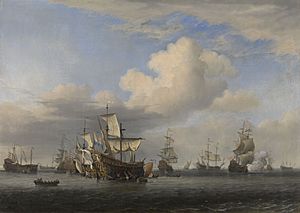
By 5 PM, the Dutch had more ships in the fight. They were attacking the English rear squadron from both sides. Two Dutch ships caught fire and were lost. Some thought they were hit by special "fiery bullets." Others believed sparks from their own cannons caused the fires.
The English fleet was heading towards shallow waters. Albemarle ordered his ships to turn northwest. Vice-Admiral Sir William Berkeley attacked with his ship, HMS Swiftsure, with little support. Two Dutch ships came to help their commander. They damaged the Swiftsure's rigging. Then, the Dutch ship Reiger boarded the Swiftsure. Berkeley was killed, and the Swiftsure was captured.
Two other English ships, the Loyal George and HMS Seven Oaks, were also captured. The body of Admiral Berkeley was later returned to England. Another English ship, HMS Rainbow, fled to a neutral port, chased by Dutch ships.
By 7 PM, de Ruyter's squadron joined the fight. The fleets fought fiercely. One English ship, the Henry, was badly damaged. It fought off three Dutch fireships and escaped, even though a third of its crew jumped overboard in panic.
Both fleets anchored for the night around 10 PM. The Dutch were happy they had survived the English attack and captured three English ships. They lost two ships to fire. The Dutch also mourned the loss of Admiral Evertsen. However, Tromp's squadron had lost contact with de Ruyter.
Second Day, English Attack
The next morning, June 2, was sunny. De Ruyter had only 53 warships with him. Tromp's 12 ships were far behind. Another 12 Dutch ships were still chasing the Rainbow. This left de Ruyter and Tromp with 65 ships against Albemarle's 48.
Albemarle thought the Dutch fleet was much smaller because of English attacks. So, he decided to attack directly at 6 AM. The two fleets passed each other several times, fighting at close range. During this time, Tromp's ships managed to join the Dutch line. Albemarle also received good news: Prince Rupert and his squadron were returning.
The first two passes were tough for the English. Three of their ships were damaged and had to return home. Around 10 AM, the wind died down, and the ships were stuck for an hour. When the wind returned, de Ruyter managed to cross the English line. He wanted to launch an all-out attack, boarding and capturing English ships.
Second Day, Tromp's Trouble
Before de Ruyter could attack, he saw that Tromp's squadron was in trouble. Tromp's ships were isolated and being attacked by the English. Six of Tromp's main ships were badly damaged. His former flagship, Liefde, was burned by an English fireship. Vice-Admiral Abraham van der Hulst was killed on another ship.
De Ruyter quickly broke through the English line to rescue Tromp. He kept the rest of the English fleet busy while he saved Tromp's ships. This was a risky move, but it worked. Tromp's ships were saved, but the Dutch lost more admirals and several damaged ships had to return to port.
De Ruyter's fleet was now down to 57 ships. They faced 43 English ships, many of which were damaged. The fleets passed each other three more times. De Ruyter's ship, De Zeven Provinciën, lost its main mast. He left the fight to oversee repairs, giving temporary command to Aert van Nes.
By late afternoon, the English fleet was in bad shape. Many ships were badly damaged, and they were running low on gunpowder. One English ship, HMS Black Eagle, sank.
Second Day, Dutch Reinforcements
To make things worse for the English, 12 new Dutch ships appeared on the horizon. Albemarle thought these were fresh forces. In fact, they were Tromp's ships that had chased the Rainbow on the first day and were now rejoining the battle.
Albemarle realized his fleet was too weak to continue. He had only 35 working ships, plus six badly damaged ones. Prince Rupert's squadron was still not there. So, Albemarle gave the order to retreat. The English fleet headed northwest, trying to escape into the Thames. The Dutch tried to catch them, but the English had a head start. During the retreat, one English ship, the St Paul, was too damaged to keep up and was burned to prevent its capture.
Both sides had missed chances for a decisive victory on the second day. The English fleet, though defeated, was not destroyed. They had only 28 ships that could be repaired for future battles. The two fleets spent the night repairing their ships.
Third Day
On June 3, the English fleet continued its retreat. The Dutch pursued them. The English had 15 strong ships in their rear-guard, which kept the Dutch at a distance.
Around 3 PM, Prince Rupert's squadron was finally sighted, heading north to join Albemarle. When the Dutch saw this, they tried to attack the English fleet before Rupert could reinforce them. However, some English ships, including the large HMS Royal Charles, HMS Royal Katherine, and HMS Prince Royal, ran aground on a sandbank called the Galloper Sand. The first two got free, but the Prince Royal, a very important ship, was stuck fast.
Several Dutch ships, including fireships, surrounded the Prince Royal. Vice-Admiral George Ayscue wanted to fight, but his crew panicked and surrendered. Ayscue was captured by Tromp. This was the only time an English admiral of such high rank was captured at sea. Tromp wanted to keep the Prince Royal as a prize. But when de Ruyter arrived, he ordered the ship to be burned. The Prince Royal's steering was damaged, and de Ruyter feared the English would recapture it.
Rupert's squadron finally joined Albemarle. The English fleet now had 52 warships and six fireships. The Dutch had about 69 warships and six or seven fireships. Even though the English were still outnumbered, they decided to continue the battle the next day. De Ruyter also prepared his fleet for a fourth day of fighting, believing his numbers could still win.
Albemarle and Rupert reorganized the English fleet. Rupert's fresh ships took the lead. Both fleets spent the night repairing damage.
Fourth Day, Early Fights
On June 4, the English scouting ships found the Dutch fleet to the south. De Ruyter planned to break the English line in three places at once. The English fleet approached, sailing southeast.
As on previous days, the fleets passed each other. Around 7:30 AM, Rupert's squadron attacked the leading Dutch ships. Vice Admiral Christopher Myngs tried to break the Dutch line. He was shot and fatally wounded, and his ship, HMS Victory, was forced to retreat. Rupert's attack succeeded, and many English ships broke through the Dutch line. However, Tromp's rear squadron also broke through the English rear, causing confusion.
Albemarle and Rupert quickly turned to attack Tromp. Tromp had fewer ships and had to retreat north. Two of his ships collided, and one was burned by an English fireship. De Ruyter had managed to break the English line, but his own fleet was also in disarray.
After Tromp withdrew, there was a brief pause as both fleets tried to reorganize. De Ruyter had about 35 ships left. Tromp and other Dutch admirals were far away. The English fleet was between them and de Ruyter. The Victory, though damaged, managed to escape capture.
De Ruyter, despite having fewer ships, had regained the "weather gauge." The fleets passed each other again. The English, with more ships and heavier guns, tried to get closer. But de Ruyter kept his ships at a distance.
De Ruyter was waiting for Tromp and other ships to rejoin him. They started to return around 3 PM. Albemarle, with about 37 ships, focused on attacking Tromp and Aert van Nes. Rupert, with about a dozen ships, held off de Ruyter. Albemarle wanted to win decisively before his ammunition ran out.
Fourth Day, De Ruyter's Attack
Albemarle attacked Tromp and van Nes at close range. An English fireship caused confusion among the Dutch. The English ship Royal Katherine badly damaged Tromp's ship, forcing him to leave the battle. Several other Dutch ships were disabled or captured. Albemarle seemed to be winning.
De Ruyter, watching from a distance, thought he had lost the battle. But after talking to another admiral, he waited for Rupert's squadron to pass. Then, he unexpectedly attacked Albemarle's rear. Albemarle's forces were tired and low on ammunition.
De Ruyter's surprise attack made some English captains lose their nerve. Rupert's ship, the Royal James, was badly damaged and had to be towed away. Seeing this, de Ruyter realized he could win. He signaled for an all-out attack, focusing on the English rear. Albemarle's flagship, the Royal Charles, was also damaged. The Dutch, also low on gunpowder, aimed to board and capture English ships. Several English ships were captured or sank.
Fourth Day, English Retreat
After the English rear was defeated, de Ruyter chased Albemarle and Rupert. The English fleet continued west towards the Thames estuary. Albemarle and Rupert later said they wanted to unite and fight again the next day. But their ships were in poor condition and lacked ammunition. Other English officers said the Dutch chased them for two hours before stopping.
De Ruyter later claimed he stopped the chase because of a thick fog. He believed it was a sign from God to humble the enemy but not destroy them completely. However, the fog was temporary. De Ruyter also had only about 40 ships left, while Albemarle had almost as many strong ships.
By the end of the third day, the Dutch had already won strategically. The English fleet was too damaged to stop Dutch trade or prevent the French fleet from joining them. De Ruyter's attack on the fourth day, though risky, sealed his victory.
After the Battle
Results of the Battle
The Four Days' Battle was the biggest sea battle of its time. It was a clear Dutch victory, even though both sides first claimed they had won. The Dutch had a hard time winning, especially since the English fleet was much smaller for the first three days. The Dutch also lost more men, mainly on the ships that burned. The French fleet's absence meant the English fleet was not completely destroyed.
Right after the battle, some English captains claimed de Ruyter had retreated first. This usually meant admitting defeat. But the Dutch fleet had crippled the English fleet, at least for a while. The Dutch lost only four smaller ships. However, the Dutch advantage lasted only seven weeks. Many damaged English ships were repaired, and new ships joined the fleet. England also forced more men into service to get enough sailors.
About 1,800 English sailors were captured and taken to Holland. Many of them later joined the Dutch navy. Those who refused stayed in Dutch prisons for two years.
Later Fights
The Dutch leader, Johan de Witt, thought the Dutch victory was even bigger than it was. He ordered de Ruyter to attack and destroy the English fleet while it was anchored in the Thames River. He also planned to send Dutch soldiers to attack the English coast. De Witt hoped this would end the war.
De Ruyter sailed to the Thames in early July. But he found that the English had removed navigation buoys and had a strong squadron ready to defend the river. So, de Ruyter decided to block the Thames instead.
The English fleet was repaired and ready by mid-July. Rupert and Albemarle sailed out to meet the Dutch. The two fleets met on July 25 at the North Foreland in the St. James's Day Battle. This was an English victory, though they did not destroy the entire Dutch fleet. After this battle, an English squadron attacked the Dutch coast, burning many merchant ships. This caused a lot of economic damage to the Netherlands.
France and the Netherlands blamed each other for not having their fleets meet as planned. This ended their naval cooperation.
End of the War
In 1667, the English government could not afford to keep such a large fleet. This, along with a successful Dutch attack on the English navy base at Medway, made peace unavoidable. Both England and the Netherlands had put huge efforts into the war. But no side could achieve a decisive victory. England's financial problems and the Dutch need for trade led to peace.
Popular Culture
The Four Days' Battle is shown in the Dutch movie Michiel de Ruyter (2015).
See also
- St. James's Day Battle, another big battle a few weeks later.
- Glossary of nautical terms : (A–L), (M–Z)
|


